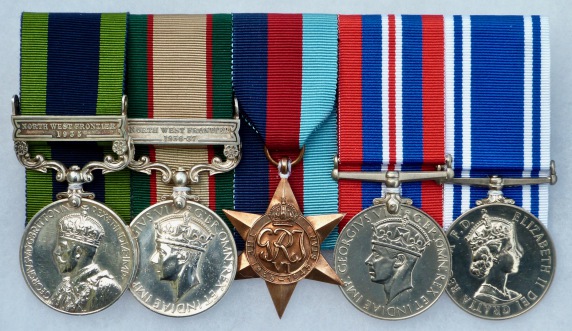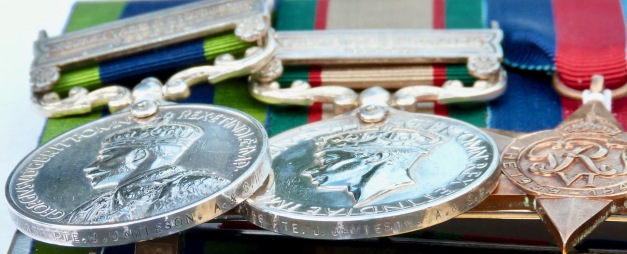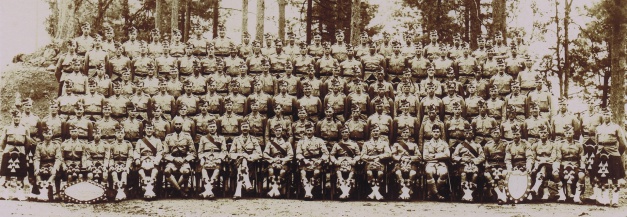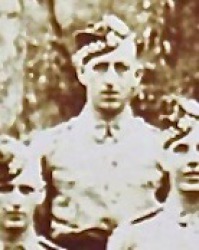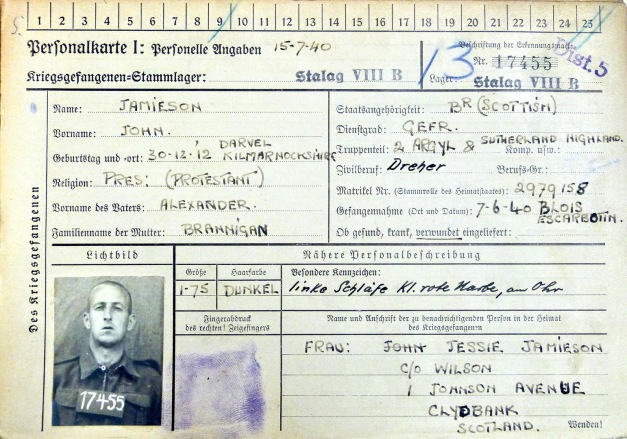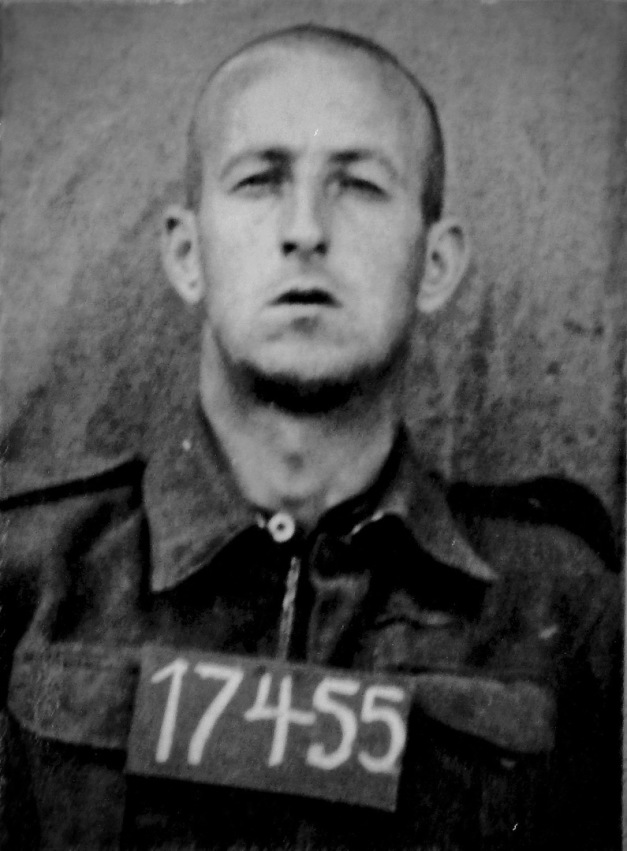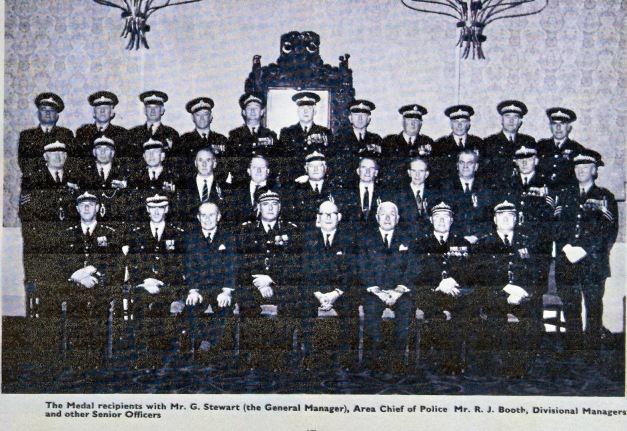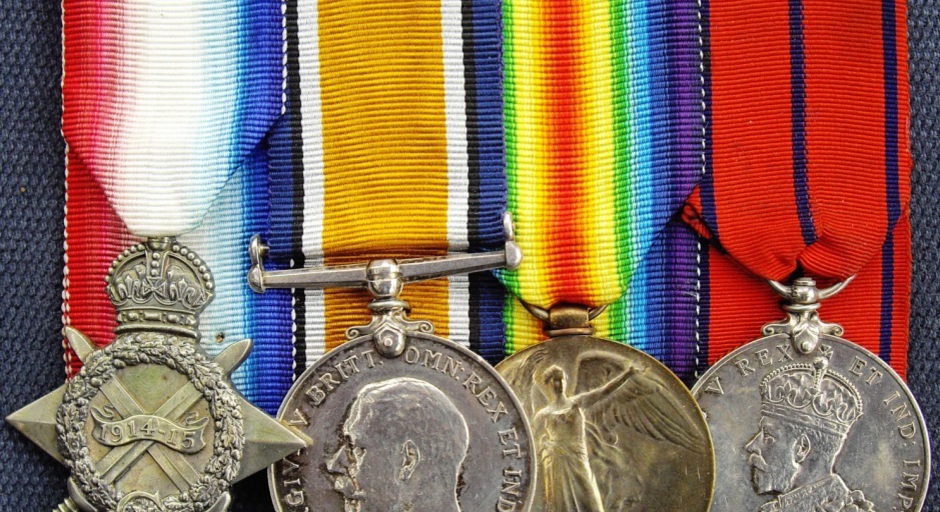
London Midland & Scottish Railway Police - British Transport Commission Police - British Transport Police - PC John Jamieson
PC John Jamieson
2nd and 8th Battalions, Argyll & Sutherland Highlanders
London Midland Scottish Railway Police
British Transport Commission Police
British Transport Police
India General Service Medal, 1908 (Clasp ‘North West Frontier 1935’)
India General service Medal, 1936 (Clasp ‘North West Frontier 1936 – 37’)
1939 – 1945 Star
1939 – 1945 War Medal
Police Long Service & Good Conduct Medal (EIIR - 1968)
Introduction
John Jamieson was born on 30 December 1912 in Darvel in Ayrshire. His father was Alexander Jamieson, a Lace Weaver and his mother, Elizabeth Seade Brannigan or Jamieson. They had been married at Darvel in September 1912.
His father died during the Great War and his mother remarried and moved to Glasgow. When he was old enough, John Jamieson enlisted in the Argyll and Sutherland Highlanders, ‘7 years with the Colours, 5 with the Reserve’. After basic training, he served with the 2nd Battalion in India. His ‘Reserve’ period commenced in early 1939 and he returned to the United Kingdom (UK) from India.
Almost immediately, he was ‘Called to the Colours’ with the 8th Battalion, part of 154th Brigade, 51st (Highland) Division of the Territorial Army. The 51st were sent to France in early 1940. After the fall of Dunkirk, the 51st were trapped in Picardy and eventually forced to surrender on 12 June that year. John Jamieson was wounded in action and captured near Abbeville about seven days earlier.
After the war, he joined the London Midland & Scottish Railway Police which later became the British Transport Commission Police, itself later named the British Transport Police. He served in the West of Scotland. He was awarded the Police Long Service and Good Conduct medal in 1968 and retired in 1972.
What follows now is a chronological record of John Jamieson’s life as recorded in a wide range of documentary sources. The text is taken verbatim for official documents and as ever, there are inconsistencies in ages etc.
The Census of Scotland 1891
The following were recorded living at West Dykeneuk Avondale in Lanarkshire on the night of the Census of Scotland 1891.
|
Name and Age |
Occupation |
Place & County of Birth |
|
John Jamieson, (27) |
Farm Servant |
Darvel, Ayrshire |
|
Margaret Sorbie or Jamieson, (26) |
Farm Servant |
Stonehouse, Lanarkshire |
|
Lily Jamieson, (5) |
Scholar |
Darvel, Ayrshire |
|
Robert Jamieson, (3) |
|
Stonehouse, Lanarkshire |
John and Margaret Jamieson are John Jamieson’s paternal grandparents.
Register of Births in Lanarkshire, 1891
Alexander Jamieson was born at West Dykeneuk in the Parish of Avondale Lanarkshire on 31 May 1891. His father, John Jamieson registered his birth.
This is the birth of John Jamieson’s father.
The Census of Scotland 1901
The Census of Scotland 1901 lists the following living at 95 East Main Street, Darvel in Ayrshire.
|
Name and Age |
Occupation |
Place & County of Birth |
|
John Jamieson, (39) |
Road Surface man |
Darvel, Ayrshire |
|
Margaret Sorbie or Jamieson, (38) |
|
Stonehouse, Lanarkshire |
|
Lily Jamieson, (15) |
Lace Darner |
Darvel, Ayrshire |
|
Robert Jamieson, (13) |
Lace Factory Boy |
Stonehouse, Lanarkshire |
|
Alexander Jamieson, (10) |
Scholar |
Dykeneuk, Lanarkshire |
|
Mary Jamieson, (7) |
Scholar |
Darvel, Ayrshire |
Register of Births in the District of Darvel in Ayrshire, 1912
John Jamieson was born on 30 December 1912 in 82 East Main Street in Darvel.
His parents were Alexander Jamieson, (21), a Lace Maker, married to Elizabeth Seade Brannigan, (22), also a Lace Machinist. His father registered his birth.
Register of Births in the Parish of Old Kilpatrick in the County of Dunbarton, 1913
Jessie Wilson was born in 50a Radnor Street, Radnor Park, Old Kilpatrick on 23 July 1913. Her parents were Joseph Wilson, a Machinist and Elizabeth Dunbar or Wilson. They had been married on 22 June 1900 in Glasgow.
Her father registered her birth. This is the birth of John Jamieson’s first wife.
British army Service Records 1914 - 1920
Alexander Jamieson, (25 years, 8 months) a Lace Maker of 78 East Main Street, Darvel enlisted as Private 202564 in the 4th Battalion Royal Scots on 22 March 1917. On 20 June 1917, he embarked from Folkstone in Kent for France.
He disembarked at Boulogne in France on 20 June and was at Etaples on 21st.
On 7 July 1917, he was posted to 16th Battalion Royal Scots (McCrae’s Battalion) in the field.
He was wounded in action with a gunshot wound (GSW) to his right arm on 28 August 1917. He died of this GSW in the 10thGeneral Hospital, Rouelle on 12 September 1917.
Much of his service record still exists in digital form and included full details of his will in which he left all of his effects to his “wife or son, John”. There are also details of his family and next of kin, his widow Elizabeth’s War Pension and his personal effects that she received. There is far too much detail for me to publish here but it is easily found in Ancestry and Findmypast.
Alexander Jamieson is buried in St Sever Cemetery in France. His widow received his British War Medal and Victory Medals. At the time of his death, Elizabeth was living in Shamrock Street in Glasgow.
Register of Marriages in the District of Milton in the Burgh of Glasgow, 1920
On 19 February 1920, at 84 Shamrock Street, Glasgow, George Ford, (21), a Brass Finisher Journeyman married Elizabeth Seade or Jamieson, (30), Widow. The witnesses were her father, James Graham Brannigan and her mother, Elizabeth Seade or Brannigan.
Register of Deaths in the District of Milton in the Burgh of Glasgow,1929
Elizabeth Ford, married to 1st, Alexander Jamieson, Lace Weaver and 2nd, George Ford, Postman, of 124 New City Road, Glasgow, died there on 9 May 1929. Her husband registered her death.
British Army Service Records, 1932
On 19 October 1932, John Jamieson, (19 years and 9 months) and a Warehouseman, joined the Argyll and Sutherland Highlanders (A & S H) as Private 2979158 at the Glasgow Army Recruiting Office. He was 5’ 9” tall, fresh complexion, hazel eyes with dark brown hair.
He arrived at the Argyll’s Depot in Stirling Castle on 21 October and after completing basic training, was posted to the 1stBattalion on 13 April 1933. In November that year, he was posted to the 2nd Battalion in India.
John Jamieson served in India from 24 November 1933 until 28 February 1939 when he transferred to the Army Reserve on completion of his 7 years ‘with the Colours’.
In 1934, the battalion was at Rawalpindi and John was listed as a Lance Corporal in No. 7 platoon, No. 9 section in B Company. During his time in India, he took part in two active service campaigns, Mohmand in 1935 and in Waziristan in 1936 – 37, both of which, are now in Pakistan. He was awarded two India General Service medals with clasps for ‘North West Frontier 1935’ and ‘North West Frontier 1936 – 37’ for his service there. In 1938, he was a Regimental Policeman in X platoon of ‘B’ Company.
On 24 January 1939 at Trimulgherry (Tirumalagiri) India, his Commanding Officers signed the papers authorising his transfer to the reserve ‘on completion of his period of Colour Service…’. His time in the Reserve did not last long given the world events that followed.
On 2 March 1939, he was back at the Regimental Depot in Stirling Castle and on 29 August, he was posted to an Infantry Training Centre for an ‘Armoured Vehicle Training’ Course.
From 24 November 1939, he was posted to the 8th Battalion A & S H, a Territorial Army battalion which was part of 154 (Highland) Brigade of the 51st (Highland) Division.
Register of Marriages in the District of Old Kilpatrick in the County of Dunbarton, 1940
On 2 January 1940, at the Manse, Mill Road, Clydebank, John Jamieson, (27), a Private in 8th Battalion A & S H, Quebec Barracks, Borden, England, married Jessie Wilson, (26), a Sewing Machine Factory Machinist of 1 Johnston Avenue, Clydebank.
From her employment, it is highly likely that Jessie worked in the famous Singer’s Sewing Machine factory in Clydebank.
On 3 February 1940, John disembarked with the 51st in France. On 7 May 1940, he was allowed 10 days leave to the United Kingdom. This was the last entry on his record until 1945. Some of what happened in between is outlined below.
The 8th A & S H in France 1940
The 51st (Highland) Division was commanded by Major-General Victor Fortune and formed part of the British expeditionary Force (BEF) in France during the first few months of 1940.
With the German invasion of France and the Low Countries on 10 May 1940, the BEF advanced into Belgium to meet the advancing forces. Stationed to the south in front of the Maginot Line, the 51st was not part of the force involved in Belgium and was thus not able to take part in the Dunkirk evacuation. In response to the German advance, it was pulled back to form a defensive line along the Somme, where it was attached to the French 10th Army. With the withdrawal of the Allied forces at Dunkirk, the Germans turned their attention to the south. Many felt then and now, that Churchill sacrificed the 51st in order to keep France from capitulating earlier than it finally did on 12 June, 1940.
On 5 June, the German army began their second offensive. The 51st was tasked with holding a line four times longer than that would normally be expected of a division. Sustained attacks over 5 – 6 June caused heavy losses, particularly among the 7th Battalion Argyll and Sutherland Highlanders, against whom, the main thrust of the German attack came. The other battalions of the 154th Brigade were surrounded and those elements outside the trap were forced to retire to the west.
John Jamieson was a Lance Corporal with the 8th Battalion D Company near Escarbotin having been given the task of holding a large manor house in woods on the edge of the village. Unbeknown to them, the Germans were already in possession of the manor house. Members of 16 Platoon, D Coy were badly shot up in attempting to take the objective and were forced to withdraw and regroup to the east. Several actions took place around the area of the village and it was in one of them that John Jamieson was wounded and captured. It was here that several elements of the company were surrounded and overcome by the enemy. In his Liberated Prisoner Questionnaire, (WO 344/161/1), John Jamieson stated that he was wounded and captured near “Escarbotin, Pas-de-Calais, France on 5th June 1940”.
Meanwhile, the 152nd and 153rd Brigades along with the French 9th Corps, under Lieutenant-General Marcel Ihler, were cut off from the main Allied forces, and forced to withdraw towards Le Havre for a possible evacuation by sea. The remains of 154th Brigade were detached to form the ‘Arkforce’ and tasked with maintaining an open line of communication with Le Havre.
As the force moved back toward the coast, German forces reached the area near St Valery-en-Caux first, cutting off the line of retreat to Le Havre. The French and British forces pulled back into St Valery-en-Caux.
St Valery-en-Caux was a small harbour surrounded by steep cliffs giving the Germans a ready line of fire against any attempt at withdrawal. General Fortune could not hold out for long and realised the last chance was to be evacuated by sea overnight on 11/12th June, but no ships came. There were many Royal Navy ships lying off St Valery-en-Caux, but all were forbidden to approach by London. On the morning of 12 June 1940, the French forces surrendered, to be followed thirty minutes later by the British.
More than 10,000 members of the 51st (Highland) Division were captured around St Valery. Along with thousands of others, he endured a forced march through France, Belgium and Holland into Germany and captivity initially in Stalag VIB east of the village of Versen in the Emsland District of north western Germany , close to the border with the Netherlands. About a month later, he and many of his fellow prisoners were placed in cattle trucks to Stalag VIIIB at Lamsdorf in Silesia, in south east Poland and now known as Lambinowice. Jamieson arrived there, according to the International Red Cross (IRC), on 15 July 1940. In placing the prisoners far behind the front line, the Germans complied with the Geneva Convention. It also meant that to successfully escape, they had to negotiate thousands of miles of hostile territory.
Although Stalag VIIIB was a huge camp, many of its inmates were actually on detached work parties in various ‘Arbeitskommando’ (Work parties). On 2 August 1940, John Jamieson was put to work in a coal mine at Gleiwitz. On 11 December the same year, he was moved to Oehringen on ‘Kommando E22’ (Work Party E22), also a coal mine and was there until liberated by the Soviet Army in March 1945.
John Jamieson’s Prisoner of War Number was 17455 and his German record card from Stalag VIIIB Lamsdorf can be seen below. The date ’15.7.40’ can be clearly seen at the top.
By finding this POW picture, it has been possible to identify John Jamieson in the above B Company picture taken in India in 1937 as the man in the top left corner on the very back row.
He disembarked in the United Kingdom on 11 May 1945 although, where is not recorded in his Army record. From 9 August, he was posted to 11th Battalion the Argyll’s. In a note dated 11 August 1945, Lance Corporal Jamieson ‘relinquished the rank with effect from 12 July 1945’. On 22 August, he was transferred to 16th Battalion ‘RAOC’ (Royal Army Ordnance Corps).
The final note on his Army records states:
“Medically examined AFW 3149 Completed: 9/10/45.
Posted to “Y” List & S.O.S. on 3/11/45.
Proceeding to No. 6 M.C.U.
Granted 1st Award of LS & GC pay
3d per day w.e.f. 18 Jan 41.
Proceeded on release leave (Date) 4-11-45.
Released to Class “Z”
Royal Army Reserve
Date: 2-3-46
(Class “A” Release).”
I have been unable to establish the exact date that John Jamieson became a Railway Constable, but he was certainly in the job by 3 January 1948 as that was his occupation on his late wife’s death certificate. Given where he was living, I am fairly sure he was employed by the London, Midland & Scottish (LMS) Railway Police.
Register of Deaths in the District of Old Kilpatrick in the County of Dunbarton, 1948
Jessie Jamieson, (34), married to John Jamieson, Railway Constable, of 1 Johnston Avenue, Clydebank, died at home on 3 January 1948. She was the daughter of Joseph Wilson, formerly an Engineer’s Storeman and Elizabeth Wilson, M.S. Dunbar. John Jamieson registered her death.
British Transport Commission Police
British Transport Commission Police came into being on 1 January 1949.
Register of Marriages in District of Stranraer in the County of Wigtown, 1949
On the 9th day of September 1949, at the Buck’s Head Hotel, Stranraer, John Jamieson, (36), a Railway Detective and Widower of 3 Bowling Green Road, Stranraer, married Henrietta Boyd Cousins, (30), a Spinster of 37 St John Street, Stranraer.
John Jamieson’s parents, both deceased, were as shown above. His wife’s parents were Samuel Boyd Cousins, a Locomotive Storeman (Retired) and Henrietta Sutherland Cousins, M.S., McMillan.
British Transport Commission Police Journal July 1950
Volume 1, edition Number 8 of the British Transport Commission Police Journal of July 1950 on page 5 carried a report headed:
"Scottish Area - The following interesting cases have been dealt with by the British Transport Police in Scotland:-
Stranraer
For some time past, it was noticed that an increase in complaints of pilferage to goods traffic in transit from Scotland to Ireland was taking place. The traffic was sent by rail to Stranraer, from which port it was shipped by Executive boats to Larne, Ireland.
British Transport Police officers came to the conclusion that the trouble was at Stranraer, whilst the traffic was being loaded into the holds of the boats.
On 6th April 1950, PC's J. Kennedy and J Jamieson, Kilmarnock, were keeping observations near the boat at Stranraer, and they arrested a Dock Porter for stealing. This then led to the arrest of six other Dock Porters, and the recovery of a considerable quantity of stolen property. The two young Officers are congratulated on their very excellent arrests."
Presentation of Police Long Service & Good Conduct Medals, Glasgow, 1968
The British Transport Police Journal, No 83 of Spring Quarter, 1969 on page 17 carries a picture of a group of British Transport Police (BTP) officers who had just been presented with their Long Service and Good Conduct Medals at a ceremony in the St Enoch Hotel Glasgow on Friday 22 November 1968.
Among the group of thirty men, seventeen of whom are wearing groups of medals, only one man is wearing a group of four, the first two of which have the distinctive clasps of the India General Service Medals, 1908 and 1936. He is standing on the back row, 4th from the right and I believe he is PC John Jamieson. (See picture below).
Assuming PC Jamieson was awarded the medal in his twenty second year of service (the qualifying period), then he probably joined the police in 1946, not long after his discharge from the Army.
The BTP Journal No. 97 of Autumn 1972 on page 37 records a list of officers in the Scottish Area who have retired since the publication of No. 96. On that list is “Constable J. Jamieson, Stranraer”. This would have him retiring on roughly 26 years’ service, the minimum service then for a pension being 25 years. Given that he would have been 60 years old in December that year and the age limit for a PC was 55 years of age, it is likely that he applied for, and was given, extensions to allow him to complete the necessary pensionable qualification. That said, it was quite common for officers in BTP to work until age 65.
Register of Deaths in the Stranraer Area of Scotland, 1982
John Jamieson, (69), a Retired Railway Detective of 14 Caledonia Court, Stranraer, died there on 4 March 1982. His wife, Henrietta Boyd Cousins or Jamieson registered his death.
Register of Deaths in the Stranraer Area of Scotland, 1984
On 16 January 1984, at Garrick Hospital, Stranraer, Henrietta Boyd Jamieson, Widow of John Jamieson, Railway Policeman, died. Her usual address was 14 Caledonia Court, Stranraer. Her brother, Samuel B. Cousins of 24 Glen Orchard, Stranraer, registered her death.
The End of the Story
I originally bought these medals at auction as his regiment, the Argyll & Sutherland Highlanders is local to my home town and with the police LS & GC, I hoped he might have served in a local Scottish force. That proved not to be the case, but it took me a long time to establish that fact.
In the end, I spent a day at the National Records of Scotland in Edinburgh and once I found his marriage in 1940, everything else fell into place. Having found his marriage certificate and identified his parents, this led me to his early life in Ayrshire, the census’ and his father’s service in the Royal Scots.
I applied for his Army record and that gave me most of the details of his career. The Regimental Museum of the Argyll and Sutherland Highlanders in Stirling Castle were very helpful in providing details of his time in India and also the picture of B Company in 1937. My thanks to Rod McKenzie for the information. The 8th Battalion Argyll’s War Diary for 1940 is understandably quite sparse in details but assisted in providing some background.
The book, ‘After Dunkirk – Churchill’s Sacrifice of the Highland Division’ by Saul David, (1994), provides first-hand accounts of the events from the division’s arrival in France to the surrender on 12 June and the aftermath and provided a broad perspective of events from the officers and men actually on the ground at the time.
In terms of campaign medals, like all of the prisoners of war, John Jamieson was deemed only entitled to the 1939 -1945 Star and the 1939 – 1945 War Medal.
This has been a very challenging but interesting group to research, first of all in establishing which police force he served in but having done so, everything else fell into place.
As well as those mentioned above, I would also like to thank the British Transport Police History Society and especially those members who digitally saved the force journals from 1948 to 1990 that enabled me to identify when John Jamieson received his LS & GC medal and also the year of his retirement.
